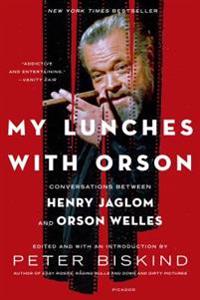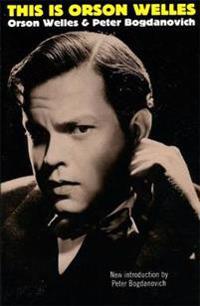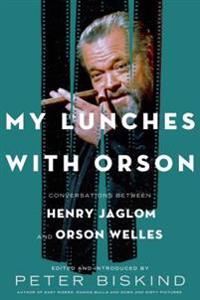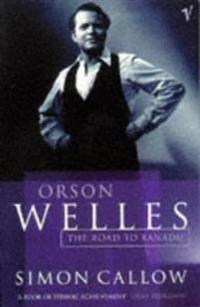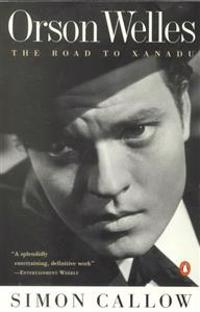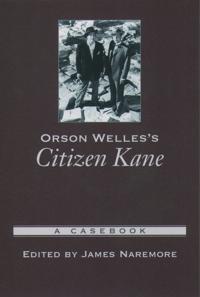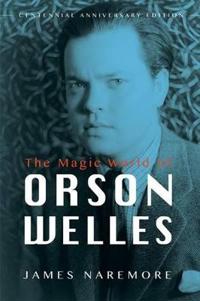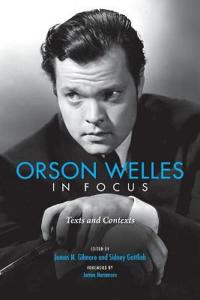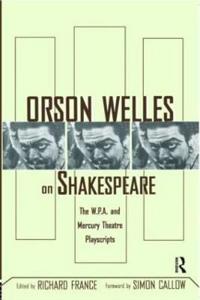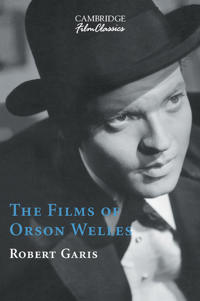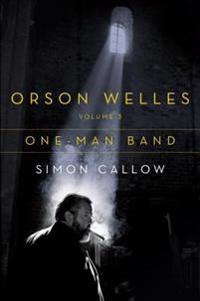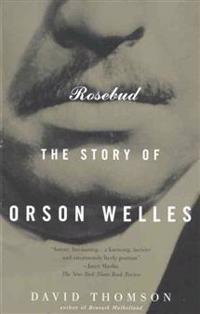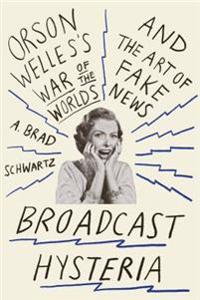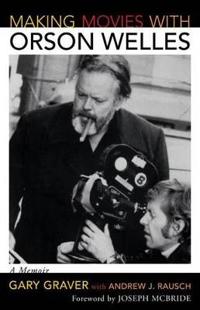My Lunches with Orson: Conversations Between Henry Jaglom and Orson Welles (Häftad)
avPeter Biskind, Orson Welles, Henry Jaglom
ISBN: 9781250051707 - UTGIVEN: 2014-06BASED ON LONG-LOST RECORDINGS, A SET OF RIVETING AND REVEALING CONVERSATIONS WITH AMERICA'S GREAT CULTURAL PROVOCATEUR
There have long been rumors of a lost cache of tapes containing private conversations between Orson Welles and his friend the director Henry Jaglom, recorded over regular lunche[...]This is Orson Welles (Häftad)
avOrson Welles, Peter Bogdanovich, Jonathon Rosenbaum
ISBN: 9780306808340 - UTGIVEN: 199803Conversations reveal Welles's feelings about films, theater, the radio and television industries, and various other directors and stars[...]
My Lunches with Orson: Conversations Between Henry Jaglom and Orson Welles (Inbunden)
avHenry Jaglom, Peter Biskind
ISBN: 9780805097252 - UTGIVEN: 201307Based on long-lost recordings, a set of riveting and revealing conversations with America's great cultural provocateurThere have long been rumors of a lost cache of tapes containing private conversations between Orson Welles and his friend the director Henry Jaglom, recorded over regular lunches in [...]
ORSON WELLES (Häftad)
avSimon Callow
ISBN: 9780099462514 - UTGIVEN: 1996-02A biography of the young Orson Welles, from his prodigious childhood and youth, his triumphs with the Mercury Theatre, to the making of "Citizen Kane".[...]
Orson Welles (Häftad)
avSimon Callow
ISBN: 9780099462613 - UTGIVEN: 1999-12The reason for the decline of Orson Welles' career is a hotly debated issue. When Citizen Kane, his first film, opened in 1941, Welles was universally acclaimed as the audacious filmmaker alive. In 1947, Welles left America for Europe and lived for the best part of twenty years in self-imposed exile[...]
Orson Welles (häftad)
ISBN: 9780099502838 - UTGIVEN: 2016-10An epic survey of Orson Welles' life and work. It shows what it was like to be around Welles, and, what it was like to be him, in which lies the answer to the old riddle: whatever happened to Orson Welles?[...]
Me and orson welles (Pocket)
avRobert Kaplow
ISBN: 9780099540199 - UTGIVEN: 2009-11-26Richard is a 17-year-old kid from New Jersey with the gift of the gab and an eye for the ladies. He's bored with school and dreams of making it big in the dazzling world of 1930s Manhattan. Miraculously, he bumps into Orson Welles outside the yet-to-open Mercury Theatre a week before Welles' history[...]
Orson Welles, Volume 1: The Road to Xanadu (Häftad)
avSimon Callow
ISBN: 9780140254563 - UTGIVEN: 1997-02In this first installment of his masterful biography, Simon Callow captures the chameleonic genius of Orson Welles as only an actor/director deeply rooted in the entertainment industry could. Here is Welles s prodigious childhood; his youth in New York, with its fraught partnership with John Housema[...]
Orson Welles's "Citizen Kane" (Häftad)
avJames Naremore
ISBN: 9780195158922 - UTGIVEN: 2004-08Citizen Kane is arguably the most admired and significant film since the advent of talking pictures. No other film is quite so interesting from both artistic and political points of view. To study it even briefly is to learn a great deal about American history, motion-picture style, and the literary[...]
Orson Welles
ISBN: 9780224079358 - UTGIVEN: 2015-11In One-Man Band, the third volume in his epic survey of Orson Welles' life and work, Simon Callow again probes in comprehensive and penetrating detail into one of the most complex artists of the twentieth century, looking closely at the triumphs and failures of an ambitious one-man assault on one me[...]
Orson Welles, Shakespeare, and Popular Culture (Pocket)
avMichael Anderegg
ISBN: 9780231112291 - UTGIVEN: 1998-11-10The Magic World of Orson Welles (Häftad)
avChancellors' Professor of English and Communication and Culture J Naremore
ISBN: 9780252081316 - UTGIVEN: 2015-06Prodigy. Iconoclast. Genius. Exile. Orson Welles remains one of the most discussed figures in cinematic history. In the centenary year of Welles's birth, James Naremore presents a revised third edition of this incomparable study, including a new section on the unfinished film The Other Side of the W[...]
Orson Welles in Italy
ISBN: 9780253010414 - UTGIVEN: 2013-09Fleeing a Hollywood that spurned him, Orson Welles arrived in Italy in 1947 to begin his career anew. Far from being welcomed as the celebrity who directed and starred in Citizen Kane, his six-year exile in Italy was riddled with controversy, financial struggles, disastrous love affairs, and failed [...]
Orson Welles in Italy (Häftad)
ISBN: 9780253010483 - UTGIVEN: 2013-11Fleeing a Hollywood that spurned him, Orson Welles arrived in Italy in 1947 to begin his career anew. Far from being welcomed as the celebrity who directed and starred in Citizen Kane, his six-year exile in Italy was riddled with controversy, financial struggles, disastrous love affairs, and failed [...]
Orson Welles in Focus
ISBN: 9780253032959 - UTGIVEN: 2018-02Through his radio and film works, such as The War of the Worlds and Citizen Kane, Orson Welles became a household name in the United States. Yet Welles's multifaceted career went beyond these classic titles and included lesser-known but nonetheless important contributions to television, theater, new[...]
Orson Welles on Shakespeare
ISBN: 9780415937269 - UTGIVEN: 2002-01This volume is the only publication available of the fully annotated playscripts of Wells' W.P.A Federal Theatre Project and Mercury Theatre adaptations, including the "Voodoo" Macbeth, the modern-dress Julius Caesar and Welles' compilation of history plays, Five Kings.[...]
It's All True: Orson Welles's Pan-American Odyssey (Övrig)
avCatherine L. Benamou
ISBN: 9780520242487 - UTGIVEN: 2007-03-14Variously described as a work of genius, a pretentious wreck, a crucially important film, and a victim of its director's ego, among other things, "It's All True", shot in Mexico and Brazil between 1941 and 1942, is the legendary movie that Orson Welles never got to finish. In this book, the most com[...]
Discovering Orson Welles (Övrig)
avJonathan Rosenbaum
ISBN: 9780520251236 - UTGIVEN: 2007-05-02Of the dozens of books written about Orson Welles, most focus on the central enigma of Welles' career: why did someone so extravagantly talented neglect to finish so many projects? Film critic Jonathan Rosenbaum has long believed that to dwell on this aspect of the Welles canon is to overlook the we[...]
The Films of Orson Welles (Pocket)
avRobert Garis
ISBN: 9780521649728 - UTGIVEN: 2004-03This book offers a comprehensive overview of Orson Welles? life and career, highlighting the shape of the filmmaker?s career, his astonishing precocity and his extraordinary gifts that resulted in both splendid successes and puzzling failures. Examining the key and recurring themes of Welles? long a[...]
Orson Welles, Volume 3: One-Man Band
ISBN: 9780670024919 - UTGIVEN: 2016-04The third volume of Simon Callow s acclaimed Orson Welles biography, covering the period of his exile from America (1947 1964), when he produced some of his greatest works, including "Touch of Evil"
In "One-Man Band," the third volume in his epic and all-inclusive four-volume survey of Orson Wel[...]Rosebud: The Story of Orson Welles (Häftad)
avDavid Thomson
ISBN: 9780679772835 - UTGIVEN: 199709A New York Times Notable Book of the Year
"Easily the best book on Orson Welles." --The New Yorker
Orson Welles arrived in Hollywood as a boy genius, became a legend with a single perfect film, and then spent the next forty years floundering. But Welles floundered so variously[...]Broadcast Hysteria: Orson Welles's War of the Worlds and the Art of Fake News (häftad)
ISBN: 9780809031641 - UTGIVEN: 2016-05On the evening of October 30, 1938, radio listeners across the United States heard a startling report of a meteor strike in the New Jersey countryside. With sirens blaring in the background, announcers in the field described mysterious creatures, terrifying war machines, and thick clouds of poison g[...]
Making Movies with Orson Welles
ISBN: 9780810861404 - UTGIVEN: 2008-09In Making Movies with Orson Welles, Gary Graver recounts the highs and lows of the moviemaking business as he and one of the most important and influential directors of all time struggled to get films produced. The two men collaborated on more than a dozen projects, including F for Fake, Filming Oth[...]
Orson Welles (Häftad)
avBarbara Leaming
ISBN: 9780879101992 - UTGIVEN: 1995-09..."[A] beautifully researched, valuable study of one of America's most influential and mysterious artists. ...[What] makes this book remarkable is Welle's own contribution. His comments, opinions, interviews cut in and out of the narrative with an almost cinematic force." -Patricia Bosworth[...]

